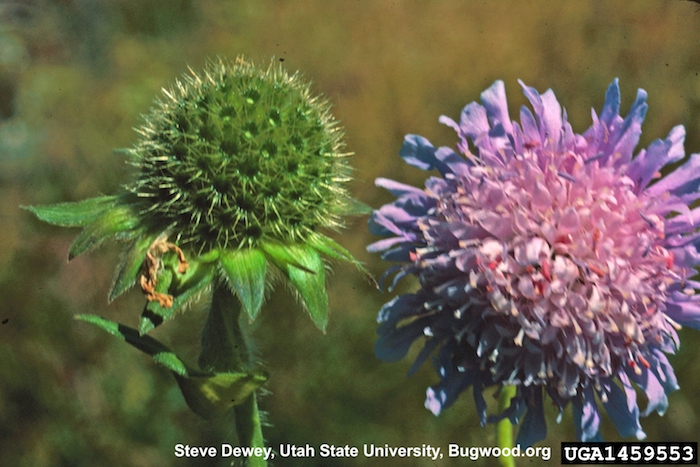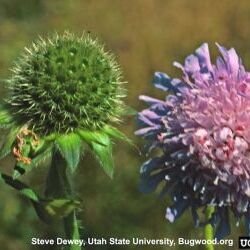
General: A hairy, perennial forb.
Height: Can grow up to 1.3 meters tall.
Flowers: Small blue to purple flowers, 4cm in diameter. The flowers appear as a single flower at the end of a long stem.
Leaves/Stems: The stems and leaves are hairy. The basal leaves are coarsely toothed & feather-shaped on the stems.
Root: Taproot
Bluebuttons
Pincushion Scabious
Butterfly Plant
Widow Flower
Gypsy's Rose
Red Clover (Trifolium pratense), exotic. Leaves are very different. Red clover leaves are palmately compound with 3 leaflets which are egg-shaped. Field Scabious leaves are deeply toothed when basal and oblanceloate when further up the stem.
Pinchushions (Scabiosa spp.), exotic. These garden plants are smaller, less hairy, with stem leaves that are toothed. Also, the corolla has 5 lobes, whereas Field Scabious corolla has only 4 lobes.
Where did it come from? Field Scabious was originally introduced from Eurasia as an ornamental.
Where does it grow here? It prefers nutrient-rich soils. It is found in most agricultural areas in BC. It flourishes along roadsides, ditches and pastures at mid elevations.
Reproduction: Reproduces by seed. A single plant can produce up to 2000 seeds per year.
When does it grow, flower & seed? Flowers July through September. Seeds in late summer.
Spreads By: Seeds primarily drop to the ground surrounding the parent plant, but can also be dispersed by animal or human activity.
Plant Type: Perennial.
- Can cause a decline in hay production.
- Invades native plant communities.
- Review your property regularly for this species.
- Treatment Small infestations can be hand-pulled. Control is best completed before it sets to seed. Cutting and Mowing is also possible since Field Scabious only reproduces by seed.
- Cover bare patches or disturbed soil by planting or seeding with non-invasives.
- Check areas where you have removed invasives for any new plants that year and in future growing seasons.
- Dispose of invasive plants responsibly. Bag them for disposal at the local landfill. Composting and burning are not recommended.
- Contact LRISS for specific treatment recommendations.
Province of British Columbia. 2002. A Guide to Weeds in British Columbia.
